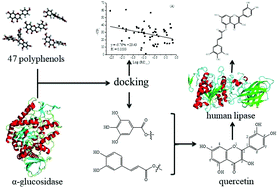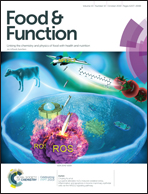α-Glucosidase inhibitors: consistency of in silico docking data with in vitro inhibitory data and inhibitory effect prediction of quercetin derivatives†
Abstract
The present study aims to investigate the relationship between in silico experimental data and in vitro inhibitory data of polyphenols against α-glucosidase. The CDOCKER protocol in Discovery Studio was used to dock various polyphenols to the Saccharomyces cerevisiae α-glucosidase crystal structure. –CDOCKER energy values and the energy gap between the highest occupied molecular orbital energy and the lowest unoccupied molecular orbital energy were used to study its consistency with in vitro inhibitory data. The results showed that the correlation trend was trustworthy regardless of the data deviation and low correlation coefficient. Despite slight disagreements with some specific polyphenols, the docking data generally explained the effect of the groups (–OH, glycosyl, galloyl, and caffeoyl). The docking results showed that compound 7, a quercetin derivative, can be recommended as a lead antidiabetic compound, with additional anti-obesity effects. Galloyl and caffeoyl moieties are favorable to develop novel αG inhibitors.



 Please wait while we load your content...
Please wait while we load your content...